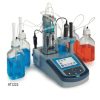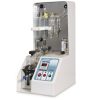TITRALAB AT1000 HACH LANGE:
Reliable results and easy setup.

Tannins are polyphenolic compounds with aromatic rings inside: many OH groups therefore have a strong propensity to capture O2 and consequently a strong antioxidant and antioxidative power.
Among their main characteristics they have the ability to bind to metals (ethyl atom chelation) such as Copper and Iron.
In addition to this, they regulate the oxidation-reduction potential of wine, therefore they can be an alternative to the use of SO2.
Tannins, oxidizing to quinones, produce H2O2: an important intermediate in the formation of ethanal, useful for the formation of stable colored compounds. Tannins-anthocyanins therefore play an important role in stabilizing the color of red wines.
The legislation allows the use of tannins from different botanical origins, from oak, chestnut and grapes.
Lysozyme in its antioxidant function
Lysozyme is a natural enzyme extracted from egg white that acts on the wall of wine lactic acid bacteria. Lysozyme used in wine production could represent a risk for consumers allergic to eggs.
It is especially effective on Oenococcus and Pediococcus, while it has no action on acid bacteria.
In red wines it also has a stabilizing action on color and tannins, while in white wines lysozyme has the drawback of leaving unstable proteins.
Chitosan in its antioxidant function
Chitosan is a biopolymer derived from chitin consisting of cell walls of various fungi (Aspergillus Niger, Agaricus bisporus) (EU authorisation for use January 2011)
It has very similar properties to SO2 in fact it has a good clarifying power, an antimicrobial action against ochratoxin, Brettanomyces, antioxidant power by delaying the oxidation of thiols responsible for the varietal aroma and a chelating action against copper, lead and cadmium










